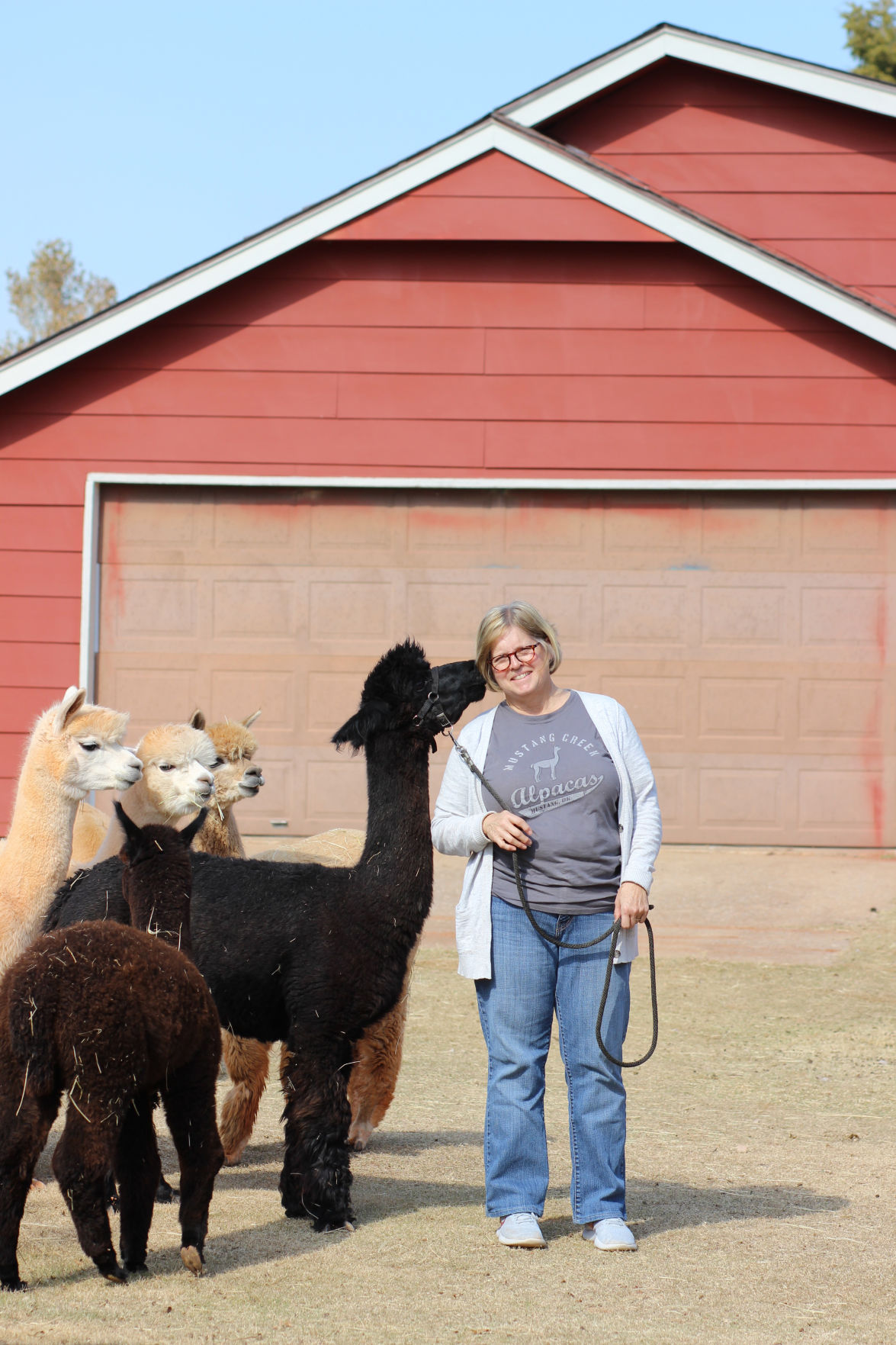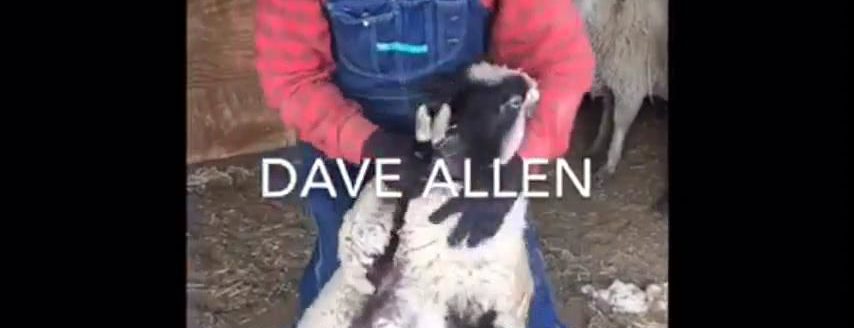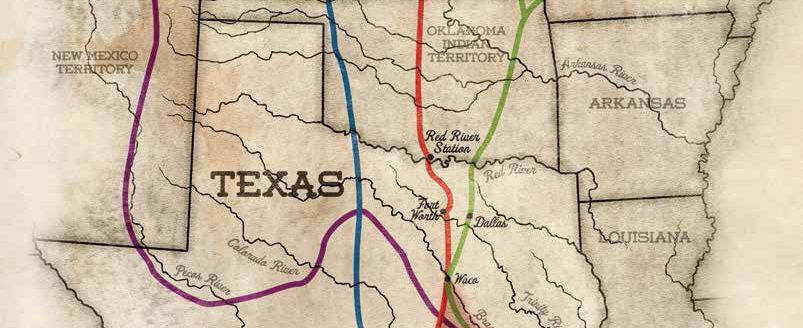Alpacas give the gift of versatility

‘Twas the night before Christmas, when all through the ranch,
Not a creature was stirring, not even a Great Pyrenes.
The children were nestled all snug in their beds,
While visions of alpaca fleece socks danced in their heads.
Kathy and Mike Fleming started Mustang Creek Alpaca Company, located in Mustang, Oklahoma, in 2010. Kathy is a knitting and crocheting enthusiast and the alpaca business became an instant fit for her. Her favorite part of owning alpacas is raising babies and selling the products she makes from the fleece of her herd. The alpacas became her full-time job in 2014. Right now, Mustang Creek consists of 31 alpacas.
Alpacas are ruminants and part of the camelid family, which includes camels, llamas, alpacas, guanacos and vicuñas. Although often confused with llamas, alpacas do not grow as big as their cousins. Kathy says there are two kinds of alpaca: Suri and Huacaya. Suris have more of a dreadlocked fleece, while Huacayas grow fuzzy fleece. Her alpacas at Mustang Creek are Huacaya. Kathy says Huacayas are more prevalent in the U.S. than the Suris. She says Suris seem to be a little more fragilely built and their fleece is not always ideal for processing.
“Suri fleece is a little harder to work with to make a product because the fleece has a lot of luster, making it slick,” Kathy said. “To pass through the processing machines, it needs to be blended with something so it can be made into yarn.”
Each alpaca produces about 7 pounds of fleece each year. Kathy says alpacas produce a dry fleece, meaning it has no lanolin, the wax secreted from sheep’s wool.
“The lanolin in sheep’s wool is what people are truly allergic to,” Kathy said. “Only about 1% of people are allergic to alpaca fleece.”
Like sheep’s wool, alpaca fleece is warm in the winter, cool in the summer and wicks moisture. Alpaca fleece can be white, black, gray or brown. Although color comes down to preference, she says some people prefer white because it is easier to dye.
Kathy says her business specializes in socks, but also sells yarn, stuffed animals, clothing and accessories. Mustang Creek Alpaca Company had a store in historic Stockyard City, in Oklahoma City, for six years. The Flemings recently closed the store because online shopping has become so popular. The business is now run from their website, www.mustangcreekalpacas.com.
Shear profit
Alpacas are sheared every spring. To shear them, they are laid on their side with their front legs pulled forward and their back legs pulled backward with pullies. One side is sheared, then the alpaca is flipped to the opposite side to shear the rest.
“Properly done, the fleece should come off all in one piece,” Kathy explained. “That’s the best part of the alpaca.”
The legs are sheared next, which is also called stove piping. The neck, tail and topknot are also cleaned up. Kathy says she gathers up the fleece from the legs, neck, tail and topknot in one bag and finds creative uses for it since it is not the most desired fleece from an alpaca. She says she uses this fleece for products like dryer balls and bird nesting balls.
The first step fleece goes through on the journey to become yarn is to be sent to the fleece mill. The fleece is placed on a skirting table where all the dirt, vegetable matter and hay is separated from the good fiber.
Coarse hair and hair that does not meet the requirements to go through the processing machines is also separated. The blanket of fleece is sent to the mill where it is washed and processed into yarn. The fleece that does not meet the requirements is also milled and it is later processed with a carding machine and made into bats. The bats of fleece can either be spun or felted.
Kathy says alpacas are relatively inexpensive to raise, in fact her Great Pyrenes, Charlie, is more costly to feed. The overhead is in the construction of the products, but that is also when the fleece becomes much more valuable.
“You can sell a nice quality fleece from anywhere to $50 to $80, so that comes out to about $7 to $10 a pound for the fleece,” she said. “You don’t make a lot off of a raw fleece. It’s when you process it into something that you profit. If you turn it into yarn, you’ve reached spinners, felters, knitters and crocheters. Socks reaches everybody who has feet. The more your process it the bigger your audience is and the more money you can make off it.”
Packin’ the flavor
Although alpacas are known for their fluffy fleece, Kathy says they are also quite tasty. Mustang Creek has turned culled alpacas into jerky and summer sausage, and it has been popular with customers. Some even process their alpaca meat into steaks, grind it up for burgers or make dog food out of it. Kathy says it is a lean meat, comparable to buffalo.
“It’s a new avenue for alpaca owners, although I’d rather knit with it,” Kathy admitted.
However, there is not a lot of whole meat on an alpaca. Kathy estimated 40 pounds at the most, limiting the amount of steaks and jerky. Additionally, alpaca are difficult to process commercially.
“USDA facilities won’t take them because they are still classified as exotic, so you have to take them to a state-inspected facility to be processed,” she explained. “The state-inspected butcher who processes the food products has to pick up the meat and transfer it to their facility to be butchered. The owner cannot come into contact with the meat until after the butcher has finished with the meat. Meat has to be packaged to sell, and you cannot sell across state lines because it’s state inspected, not federal.”
However, alpacas are no longer classified as exotic for tax purposes. They are livestock as far as the Internal Revenue Service is concerned, so owners can take advantage of every tax benefit that any rancher would receive.
More than meets the eye
Contrary to their fleecy and huggable looks, alpacas do not make good pets.
“They look like they’re cuddly and that they want you to pet them, but they are really not companions,” Kathy explained.
The Flemings do take some alpacas to events, like the Oklahoma State Fair for education and promotion reasons, and some alpacas will stand for photos, but they can only tolerate that for a certain amount of time. She says most of their alpacas are halter-trained, but if they are not worked with often, they can be difficult to manage.
As far as alpaca numbers, Kathy says there are more alpaca owners right now because their prices have gone down.
“It’s more affordable to have an alpaca than it was five or six years ago,” she said. “When the housing market crashed, the alpaca prices came down with it. People who had everything invested in alpacas, who were just breeding and selling animals, had to figure out a different avenue. That’s why people started making a lot more items out of the fleece.”
Some unorthodox uses for alpaca fleece include insulation for buildings and carpets for airplanes. She says insulation is a great use for fleece that is not good enough to be made into socks or rugs and the fleece is semi-flame resistant, making it a good option for airplanes. In addition to these products, Kathy has also turned her fleece into saddle blankets, cinches and tanned the hides of the alpacas she has butchered.
“Alpaca raising is turning the corner from an urban hobby into production agriculture,” she said.
Never underestimate the versatility of an alpaca. They offer up just about as many possibilities within the food and fiber world as any other animal that boarded Noah’s ark, only packing a little more fluff.
Lacey Newlin can be reached at 580-748-1892 or [email protected].

